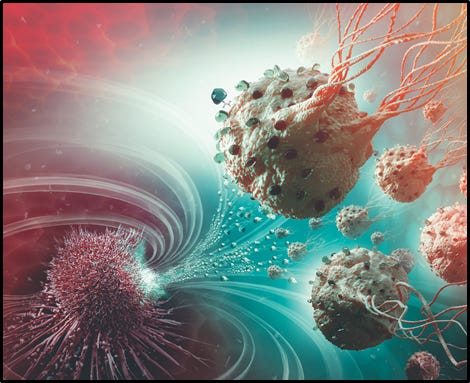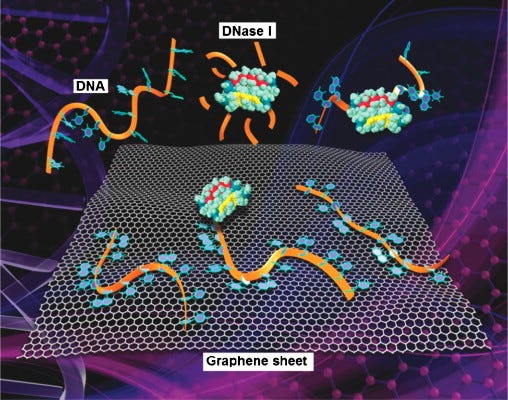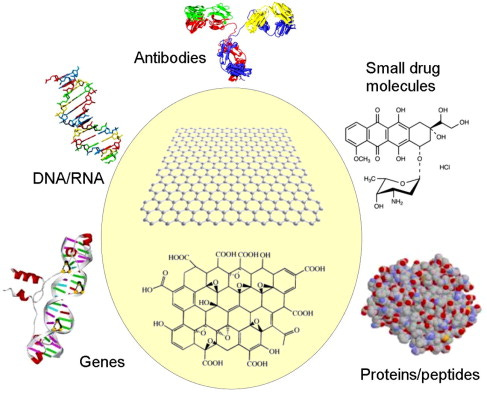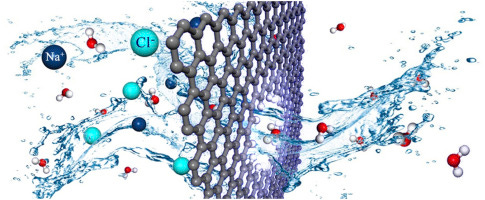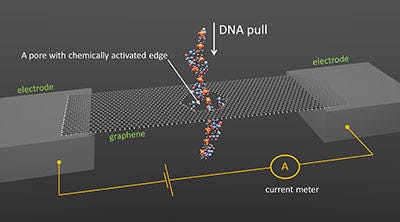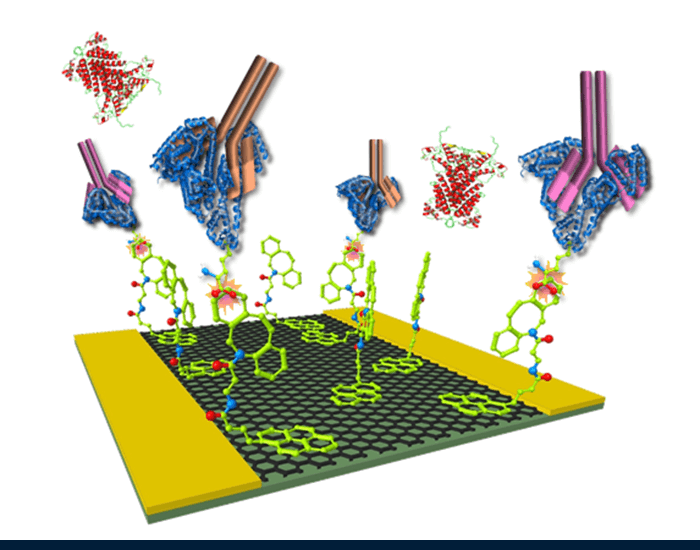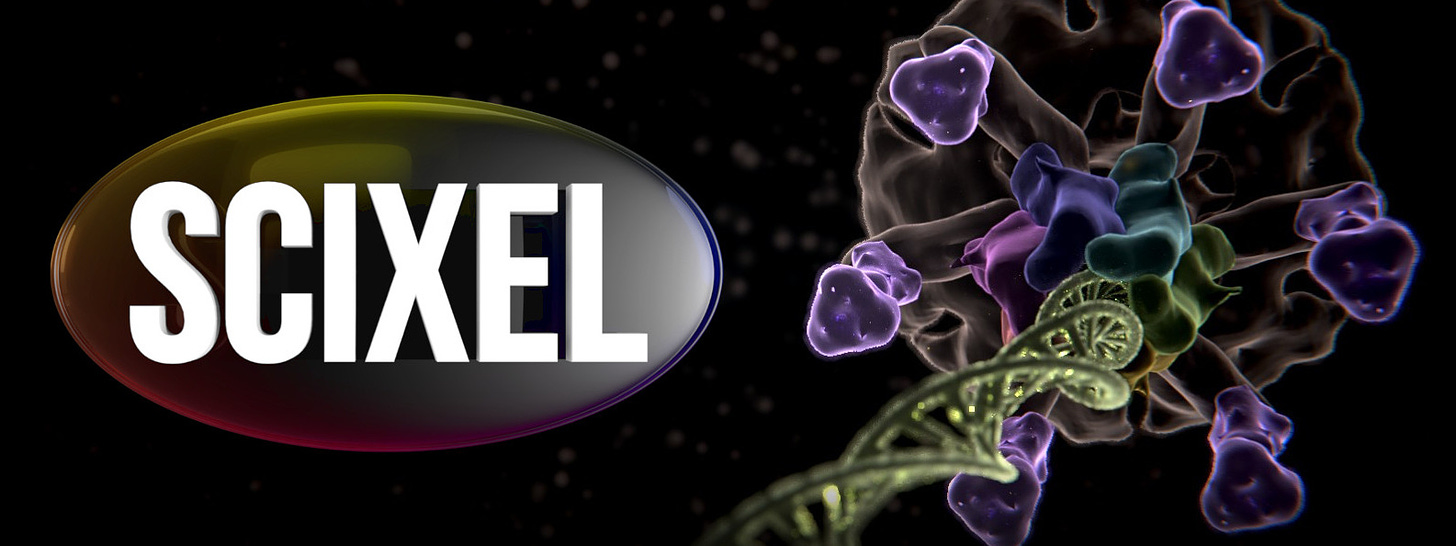Cancer represents one of the main causes of death in the world; hence the development of more specific approaches for its diagnosis and treatment is urgently needed in clinical practice. I will provide the reader with a comprehensive review of the use of two-dimensional materials (2DM) in cancer theranostic.
Schematic illustration of the constraint of DNA molecules on functionalized graphene and its effects. Single stranded DNA can be effectively constrained on the surface of graphene through adsorption. The enzyme DNase I can digest free DNA but not graphene-bound DNA
Graphene, a single layer of graphite, is undoubtedly the most famous 2-dimensional material (2DM), due to its outstanding properties that can be exploited in various applications, ranging from electronics to composites and biomedical applications. Moreover, an entire family of graphene-related materials (GRMs), each with its own properties, is available - ranging from chemical derivatives of graphene, such as graphene oxide (GO), nano-graphene oxide (NGO), and reduced graphene oxide (rGO), to new 2DMs, such as graphdiyne (GDY). Furthermore, graphene hybrids can be easily obtained by combining single or few-layer graphene (FLG) or other GRMs with different types of nanomaterials (e.g., quantum dots (QDs), metallic and semiconducting nanomaterials, etc.). Although graphene quantum dots (GQDs) are not necessarily 2D, they have been used for biomedical applications, thus these are also included in this review for sake of completeness. In addition, the family of 2DMs is very large, and other materials have started to be used in nanomedicine, for instance the family of transition metal dichalcogenides (TMDs), such as tungstenum disulphide (WS2) and molybdenum disulfide (MoS2), hexagonal boron nitride (h-BN), nitrides and carbonitrides (MXenes), black phosphorus (BP) nanosheets, silicene, antimonene (AM), germanene, biotite, metal organic frameworks (MOF), and layered double hydroxide (LDH).
Medical Applications Play to Graphene’s Strengths
Graphene-Enabled Elastic Bands Could Have an Impact in Health Monitoring
Now researchers at the University of Surrey in the UK and Trinity College in Ireland may have found another use for that flexibility—adding graphene to rubber bands to give elastics electronic properties and using the combination for health monitoring.
The research, which was published in the journal ACS Nano, developed a simple process for infusing graphene into elastic bands providing them with the electrical properties that makes them into essentially strain sensors. This means that the graphene-enabled elastic bands could be used as wearable sensors to monitor a patient's breathing, heart rate, or irregular movements.
“Until now, no such sensor has been produced that meets these needs,” said Surrey’s Dr. Alan Dalton, in a press release. “It sounds like a simple concept, but our graphene-infused rubber bands could really help to revolutionize remote healthcare–-and they’re very cheap to manufacture.”
Professor Jonathan Coleman from Trinity College, Dublin added: “This stretchy material senses motion such as breathing, pulse and joint movement and could be used to create lightweight sensor suits for vulnerable patients such as premature babies, making it possible to remotely monitor their subtle movements and alert a doctor to any worrying behaviors.”
Graphene for Wearable Sensors
Researchers at the University of Michigan have developed a graphene-based wearable sensor capable of detecting airborne chemicals that act as indicators of medical conditions. So the wearable sensor could detect diabetes by detecting the chemical acetone, which is a biomarker for diabetes.
"With our platform technology, we can measure a variety of chemicals at the same time, or modify the device to target specific chemicals. There are limitless possibilities," said Zhaohui Zhong, an associate professor at the University of Michigan, in a press release.
The research, which was published in the journal Nature Communications, is a departure from other nanosensor detection techniques. While most other nanosensors are based on detecting a change in charge density due to a molecule binding to the sensor, this graphene-based sensor is based on detecting molecular dipoles.
"Nanoelectronic sensors typically depend on detecting charge transfer between the sensor and a molecule in air or in solution," said Girish Kulkarni, a doctoral candidate and one of the researchers, in a press release. "Instead of detecting molecular charge, we use a technique called heterodyne mixing, in which we look at the interaction between the dipoles associated with these molecules and the nanosensor at high frequencies."
The graphene is the key to the extremely fast response rates of the sensor, which were clocked at tenths of a second as opposed to tens or hundreds of seconds in existing technology.
The researchers have been able to build a prototype detection system that serves as an entire chromatography system on a single chip. In future iterations of the device, a patient could wear a badge-side (?SIZED?) device to provide continuous monitoring of health conditions.
Graphene Enables Both Disease Detection and Drug Delivery
Scheme of application of graphene and GO for drug delivery of various therapeutic agents and biomolecules.
Graphene-infused elastic bands are relatively simple to produce, but graphene has also been investigated for medical applications in far more complex technologies, such as gene sequencing. Along these lines, researchers at Monash University in Melbourne, Australia have made a serendipitous discovery about graphene oxide that could lead to the material's use in disease detection and drug delivery.
What the researchers discovered was that when graphene oxide is exposed to a certain pH level it transforms into liquid crystal droplets. This could make considerably easier the process of making graphene into a spherical form, which previously required atomizers and other mechanical equipment.
“To be able to spontaneously change the structure of graphene from single sheets to a spherical assembly is hugely significant. No one thought that was possible. We’ve proved it is,” said Monash's Rachel Tkacz in a press release. “Now we know that graphene-based assemblies can spontaneously change shape under certain conditions, we can apply this knowledge to see if it changes when exposed to toxins, potentially paving the way for new methods of disease detection.”
In addition to disease detection, the researchers have also considered that this the spontaneous transformation of graphene oxide into liquid crystal droplets could lead to a drug delivery method.
“Drug delivery systems tend to use magnetic particles which are very effective but they can’t always be used because these particles can be toxic in certain physiological conditions,” said Mainak Majumder, one of the researchers, in the release. “In contrast, graphene doesn’t contain any magnetic properties. This combined with the fact that we have proved it can be changed into liquid crystal simply and cheaply, strengthens the prospect that it may one day be used for a new kind of drug delivery system."
6 applications of Graphene for medical treatments
1. Graphene as an Anticancer agent
Graphene is very useful to treat cancer cells, a method based on injecting the patient with graphene particles, chemically modified to adhere to cancer cells. As this material absorbs infrared light, the irradiation of the radiological treatments with which the tumor is treated acts directly on the damaged cells, without affecting the rest of the body, causing fewer side effects in the patient.
And a great example is the recent discovery of a team of researchers from the University of Illinois, who have observed how graphene can differentiate between healthy and cancerous cells, thus becoming a very interesting possible method for detecting cancer in a non-invasive way. The first test was simple as well as surprising since these scientists took samples of mouse brain cells and deposited them on a sheet of graphene, proving that it had the ability to differentiate between healthy cells and cancer cells. But how does it work?
Everything is based on the hyperactivity of tumor cells, which show great electrical activity. Therefore, as graphene is an excellent conductor of electricity when it comes into contact with one of these cells, it collects a large number of electrons, which significantly changes the vibration energy of its carbon atoms.
Logically, this cannot be verified with the naked eye, but it can be easily detected with the help of high-resolution vibration energy maps, due to which these researchers managed to successfully differentiate healthy cells from cancer cells.
It will still be necessary to carry out new tests to be sure of the effectiveness of graphene to detect cancer, but for now, all the signs seem to be very positive. Hopefully, it can really be applied, as the first step in fighting disease as terrible as cancer is to detect it as soon as possible. Graphene has the capability to develop diagnostic tools, against cancer or tissues.
2. Graphene in Implants
Brain Implants Made of Graphene - What is Possible?
Due to the biocompatibility of Graphene, it converts light into electrical impulses that are transmitted to the brain through the optic nerve, transforming the signal into images. Neural implants replace damaged organic tissues when nerve cells function basically by means of an electric current. Graphene can be a replacement for injured nerve circuits.
3. Graphene in Dental Implants
Graphene as new strategy for designing and manipulating dental implants and tissue regeneration. A Endoosseous dental implant structure composition: (1) prosthesis part for mastication (restoration), (2) titanium abutment for the connection of fixture and prosthesis, (3) titanium implant fixture with surface treatment. B Process osseointegration: left after 4 weeks, mineralized new bone be contacted implant fixture surface, right after 12 weeks, processing bone remodeling, bone be surrounded by blood, adipose cell, collagen fiber, monocyte, and so on. So, the titanium implant was more difficult to remove. C Various titanium implant surface treatment for osseointegration, biocompatibility, and antibacterial effect: machined surface for only mechanical effects, anodic oxidation surface by nanotube, resorbable blast media(RBM) surface using calcium phosphate, and RBM + anodic oxidation surface. Dental implant using graphene showed that enhanced cell viability and stem cell differentiation. Courtesy: Chan Park´s Group - Department of Prosthodontics, School of Dentistry, Dental Science Research Institute, Chonnam National University, Korea
This research was initiated at the University of Alicante. The professionals evaluated the feasibility of incorporating graphene to materials related to dental implants, to increase its durability. The research emerged as an alternative to solve the shortages of materials used in the manufacture of dental implants. The objective was to develop resins and composite materials that incorporated graphene in their composition. From the results of the study, graphene was incorporated as a material associated with dental implants.
Later studies look for new applications of the material. One conducted at the Chalmers University of Technology in Sweden used graphene to create a layer of vertical splinters. They managed to form a protective surface in dental implants. This prevented bacteria from clinging to it. The objective was to protect the patient against infections, eliminate the application of antibiotics and reduce the risk of treatment rejection. Prostheses placed on dental implants processed with graphene have greater resistance as well as greater structural stability and flexibility. In addition to being lighter and more flexible. The durability of this treatment is a priority for all dentists specialized in implantology and also for patients. The commitment to nanotechnology in the dental sector by creating polymers with graphene for biological use may help to increase the success of the treatment as requested by dental implants.
4. Graphene in Water Purification
Graphene sheets are more efficient and cheaper for purifying water efficiently. These sheets don’t allow the impurities to pass through it but allow water to pass through it. The use of Graphene for Water Purification has been explained earlier and this is an important application to provide clear and pure water to the people of the world who do not have the access to clean water and are affected by various diseases.
5. Graphene in DNA sequencing
Courtesy: NIST concept for DNA sequencing through a graphene nanopore. Credit: Smolyanitsky/NIST
By improving the study of diseases of genetic origin, this membrane-converted material can be submerged in the conductive fluid and apply energy voltage to extract the DNA through the tiny pores in the graphene.
6. Graphene as a Biomarker
Graphene-Based Biosensor Identifies Circulating Biomarkers of Aging
Graphene acts as a sensor for blood pressure, blood sugar levels and nitric oxide in oxygen. It also acts as a sensor in the dental field with carefully constructed peptides, which detects bacteria individually, determining the kind of pathology that makes us sick. It is an immunosensor that allows you to detect infinitesimal amounts of some substances such as growth hormone.
Born in 2012, Scixel is a project devoted to the improvement of the scientific comunication through the creation of graphical products: pictures, animations, graphs, posters, etc. Scixel consists of scientists with a deep knowledge in digital graphics but also with a long experience in giving talks, preparing posters and papers and other daily situations of scientific work.
We have focused our work into universities and research institutes all over the world: TuDelft (The Netherlands), NIMS (Japan), Basel University (Switzerland), Universidad Autónoma de Madrid, CNB or ICFO (Spain), to name a few.
Web: https://scixel.es/
If you are a company or an individual who would like to place your advertising in my newsletter you can contact me (email) and let me know your request of type of ad and number of newsletters you would like to place it. I will send you a budget as soon as possible.




